Welcome to “Blue Birds In Idaho (+ Free Photo Guide)”, your essential guide to exploring the vast and varied world of blue birds found throughout the state of Idaho. Known for its breathtaking natural beauty, Idaho is a landlocked state located in the Pacific Northwest region of the United States, characterized by its rugged mountains, dense forests, and numerous lakes and rivers.
Idaho is home to a diverse range of wildlife, including a spectacular array of birds adorned with feathers in all shades of blue. This guide will provide you with detailed information on each species, complete with photographs to help you identify them in the wild. Whether you’re a seasoned birdwatcher or a curious beginner, this guide is designed to assist you in your journey of discovery through Idaho’s rich birdlife.
Blue Birds Found In Idaho
The geography of Idaho is incredibly diverse, ranging from the arid landscapes of the Snake River Plain to the mountainous terrains of the Rockies. This variety of habitats makes it a haven for a wide range of bird species. The state’s numerous water bodies attract a variety of waterfowl, while the forests are home to many different songbirds and raptors.
Blue Jay
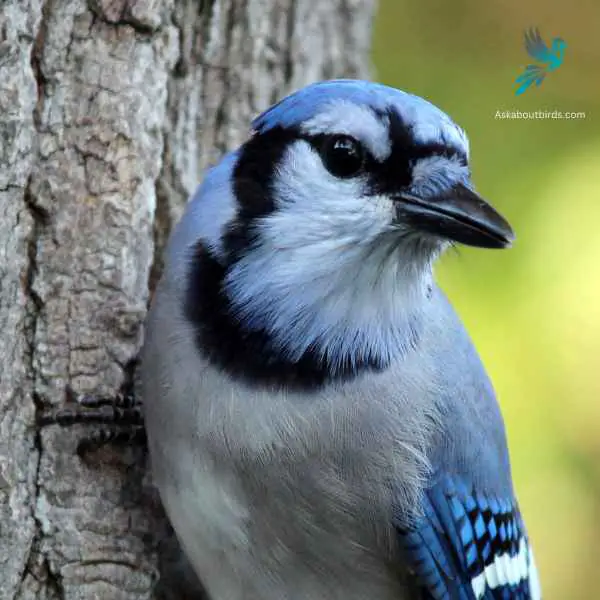
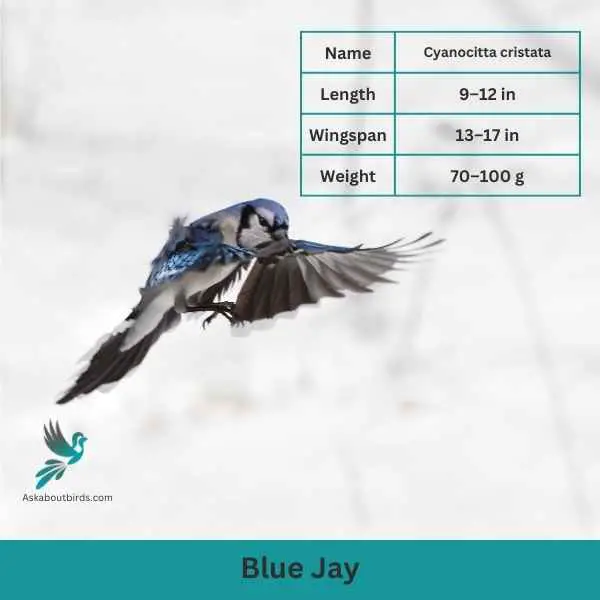
| Feature | Measurement |
|---|---|
| Scientific Name | Cyanocitta cristata |
| Length | 9–12 in |
| Wingspan | 13–17 in |
| Weight | 70–100 g |
The Blue Jay is a vibrant and easily recognized bird, known for its intelligence, distinctive calls, and bold behavior, commonly found throughout the eastern and central United States.
Appearance: The Blue Jay sports a striking blue upper body with white and black markings. Its face has a pronounced white patch with a black necklace that runs across the throat and around the head. The bird also features a pronounced blue crest, which can be raised or lowered, and its wings and tail are brightly colored with black bars and white tips.
Diet: Blue Jays are omnivores. Their diet consists primarily of seeds, nuts, especially acorns, fruits, and small insects. They’ve also been known to eat eggs or nestlings of other birds occasionally. Blue Jays often store food items in caches to eat later.
Reproduction: Blue Jays are monogamous birds that form long-lasting pair bonds. They typically build their nests in trees or large shrubs, constructing them from twigs, grass, and sometimes using mud as a binder. The female lays a clutch of 3 to 6 eggs, which are pale blue or sometimes white with brown speckles.
Belted Kingfisher

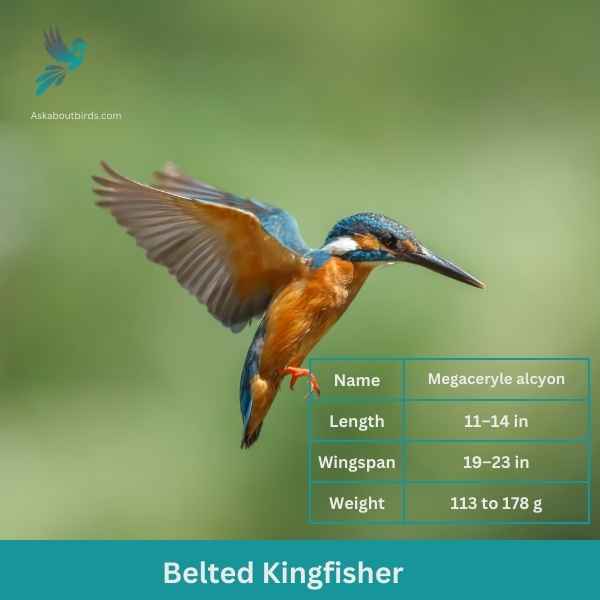
| Feature | Measurement |
|---|---|
| Scientific Name | Megaceryle alcyon |
| Length | 11–14 in |
| Wingspan | 19–23 in |
| Weight | 113 to 178 g |
The Belted Kingfisher is a distinctive and easily recognizable bird, frequently observed near water bodies, where it can be seen diving headfirst to catch prey.
Appearance: Sporting a prominent crest, the Belted Kingfisher has a slate blue-gray upper body and white underparts. Males possess a single blue band across their white chests, while females have an additional rufous band, making them one of the few bird species where females are more brightly colored than males. Their bill is long, sharp, and dagger-like.
Diet: As expert fishers, Belted Kingfishers mainly prey on small fish, but they’ll also consume crustaceans, insects, and amphibians. They’re known for their hunting tactic of hovering over water, spotting their prey, and then diving swiftly to snatch it.
Reproduction: Belted Kingfishers nest in burrows which they excavate in sandy or earthen banks, usually adjacent to water. The tunnel can be anywhere from 3 to 6 feet long, ending in a chamber. Within this chamber, the female lays a clutch of 5 to 8 white eggs.
Mountain Bluebird
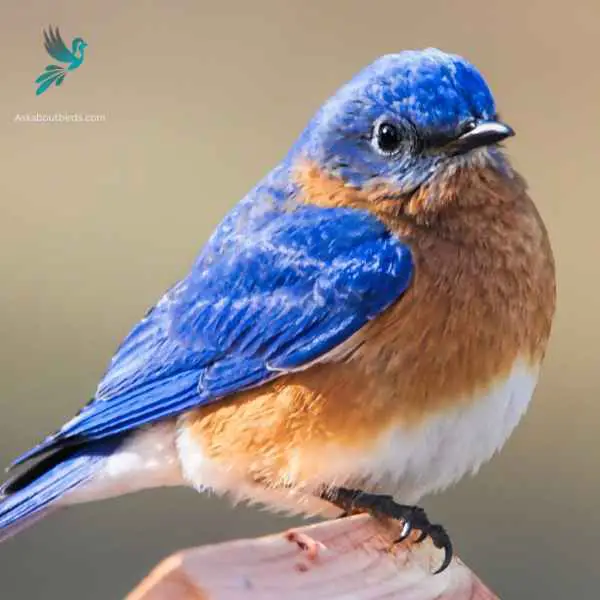
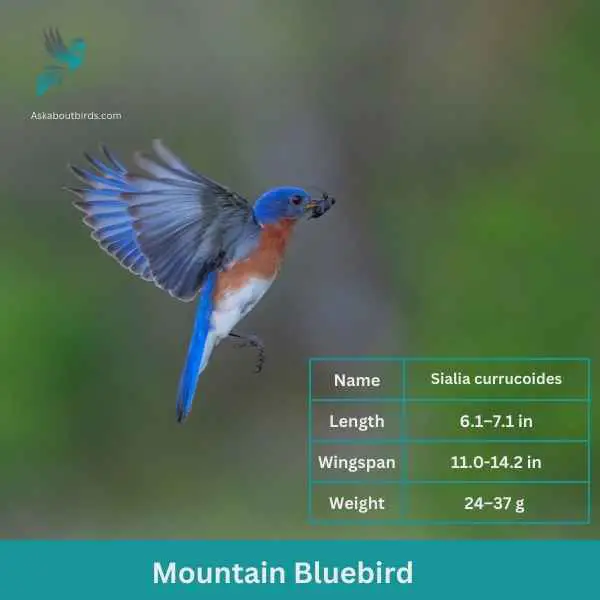
| Feature | Measurement |
|---|---|
| Scientific Name | Sialia currucoides |
| Length | 6.1–7.1 in |
| Wingspan | 11.0-14.2 in |
| Weight | 24–37 g |
The Mountain Bluebird is a small bird found in open grasslands and rocky mountains of North America. It is known for its stunning blue plumage, which is particularly vibrant in males. Females, on the other hand, have a more subdued blue coloration with hints of gray. These birds have slender bodies and a slightly curved bill, adapted for catching insects on the wing.
Mountain Bluebirds are insectivores, feeding primarily on insects such as beetles, grasshoppers, and spiders. They are skilled aerial hunters, capable of capturing their prey in mid-flight. During breeding season, these birds build their nests in tree cavities or man-made nest boxes, where females lay a clutch of eggs. The male bluebird actively participates in nest-building and provides food for the female during incubation.
Western Bluebird
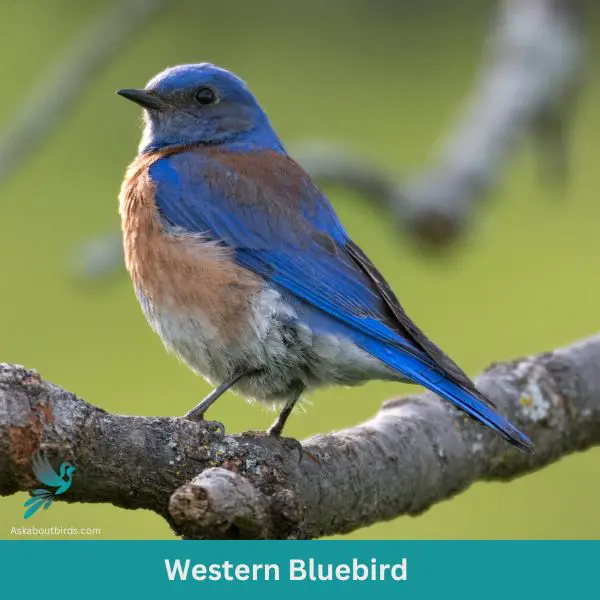
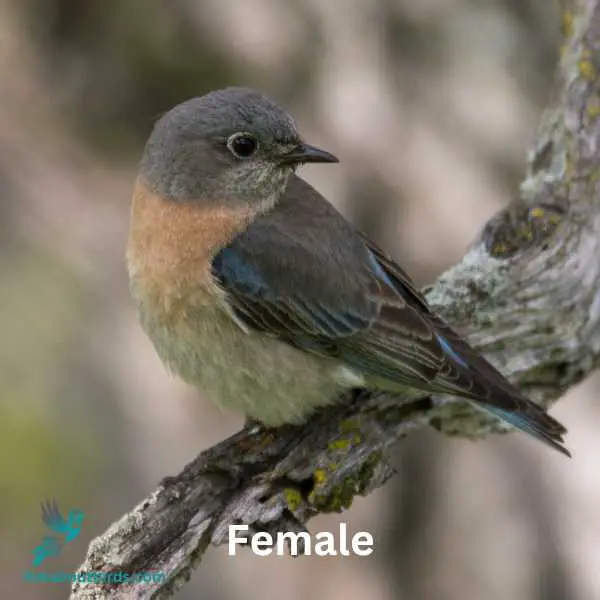
| Trait | Western Bluebird |
|---|---|
| Scientific Name | Sialia mexicana |
| Length | 5.5-7 inches |
| Wingspan | 11-13 inches |
| Weight | 0.8-1.1 ounces |
The Western Bluebird is a charismatic bird, appreciated for its vivid coloring and melodious song, commonly observed in open woodlands and meadows of the West.
Appearance: The male Western Bluebird sports a dark blue head, throat, wings, and tail with an orange breast and sides, transitioning into a grayish belly. Females are more muted, displaying grayish-blue wings and tail with a more subdued orange wash on the chest.
Diet: Western Bluebirds predominantly feed on insects, complemented by berries and fruits when available. They hunt by perching and then diving to the ground to capture their prey, and they’re also known to catch insects in mid-air.
Reproduction: These birds often utilize natural tree cavities or nest boxes for breeding. The female builds a loose nest inside and lays a clutch of 4-6 pale blue eggs.
Eastern Bluebird
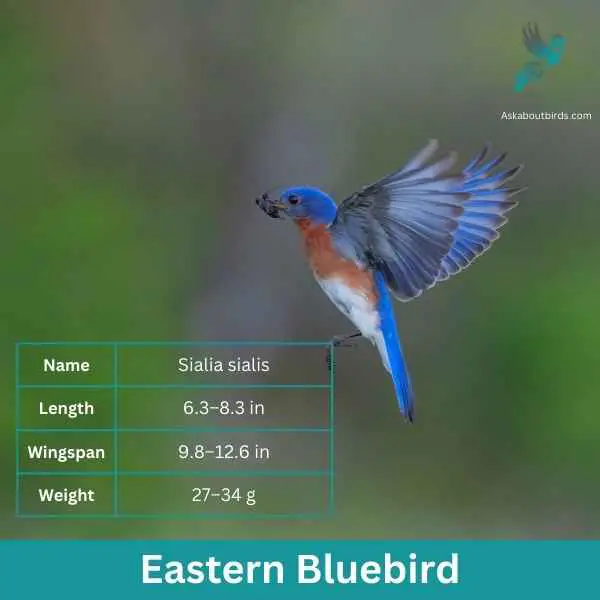
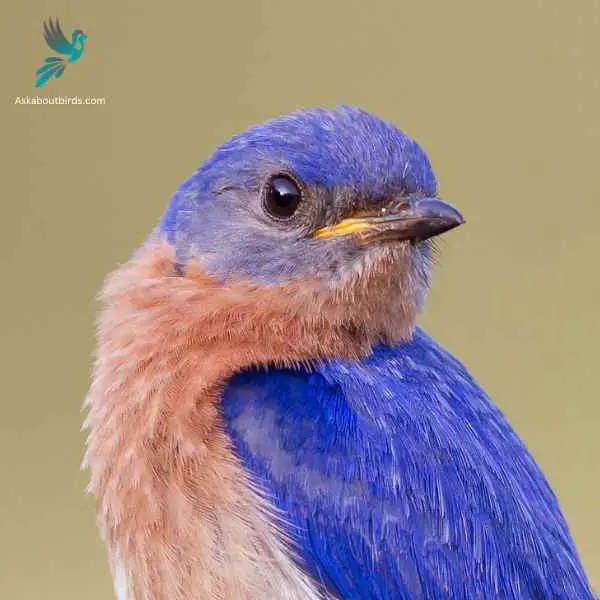
| Feature | Measurement |
|---|---|
| Scientific Name | Sialia sialis |
| Length | 6.3–8.3 in |
| Wingspan | 9.8–12.6 in |
| Weight | 27–34 g |
The Eastern Bluebird (Sialia sialis) is a small thrush found in open woodlands, farmlands, and orchards, and is recognized for its vibrant blue and red coloration. Male Eastern Bluebirds are dazzling with bright blue upperparts and a rusty or brick-red throat and breast, while females, though less colorful, still offer a similar pattern. The bird is native to North America and is commonly seen east of the Rockies, from Canada to the Gulf States and southeastern Arizona to Nicaragua.
Eastern Bluebirds feed on insects, wild fruit and berries. They have a gentle nature and are often seen perched alone or in small groups in the open, scanning the ground for prey. They are cavity nesters and will use old woodpecker holes or birdhouses if they are the right size.
Steller’s Jay
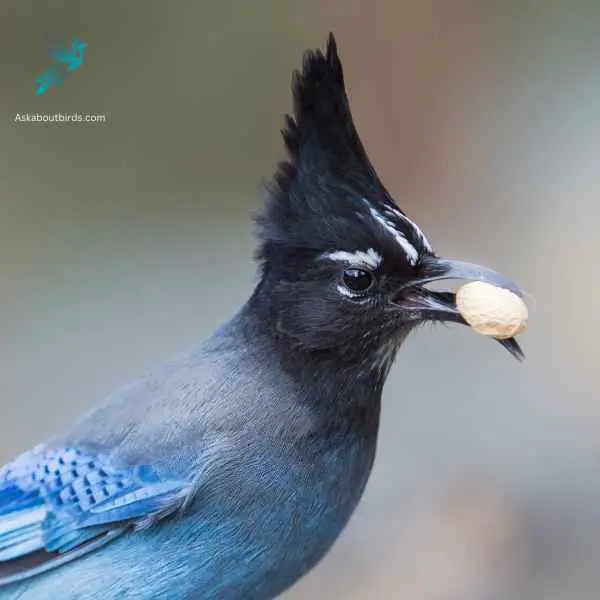
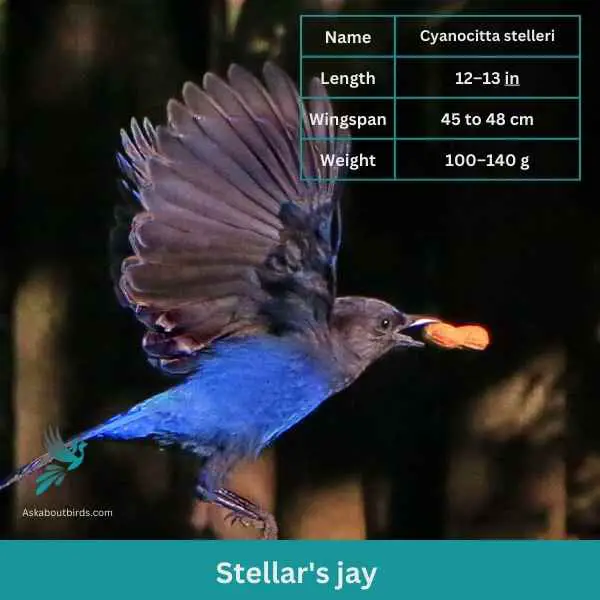
| Feature | Measurement |
|---|---|
| Scientific Name | Cyanocitta stelleri |
| Length | 12–13 in |
| Wingspan | 45 to 48 cm |
| Weight | 45 to 48 cm |
The Steller’s Jay is a charismatic and easily recognizable bird found mainly in the coniferous forests of the western North America, known for its bold behavior and loud, varied calls.
Appearance: The Steller’s Jay has a striking color contrast with a deep blue body and wings and a blackish head and upper body. One of its most distinguishing features is the tall, dark crest on its head, which can be raised or lowered depending on the bird’s mood. Its eyes are dark and its beak is strong and black.
Diet: The Steller’s Jay is omnivorous. It feeds on a wide range of items, from seeds, nuts, and berries to insects and small animals. It’s also known to raid campsites and picnics, often scavenging for human food.
Reproduction: Steller’s Jays form monogamous pairs that often remain together for several years. They typically build their nests in coniferous trees, made from twigs, moss, and other plant materials. The female lays a clutch of 2 to 6 eggs, which are usually pale green or blue with brown spots.
Western Scrub-Jay
Lazuli Bunting
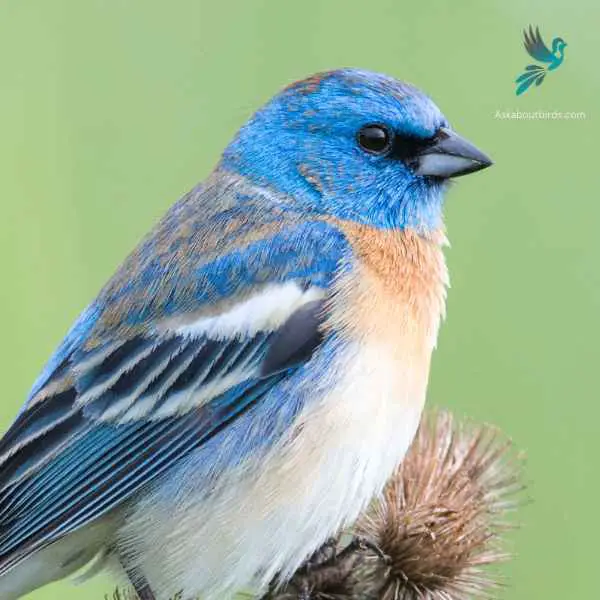
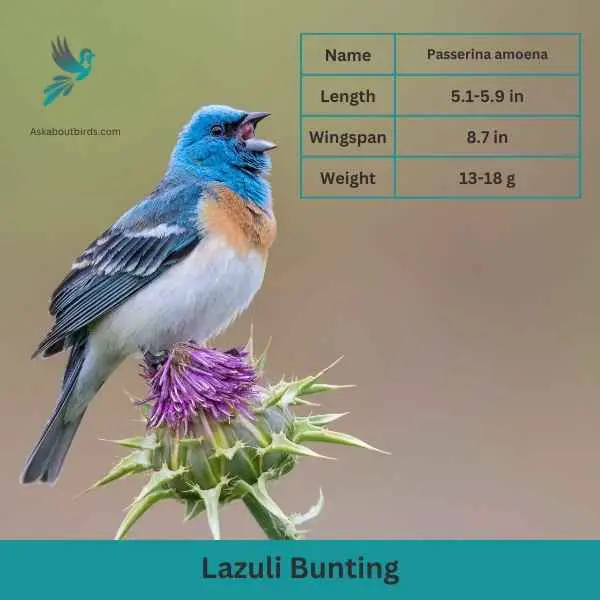
| Feature | Measurement |
|---|---|
| Scientific Name | Passerina amoena |
| Length | 5.1-5.9 in |
| Wingspan | 8.7 in |
| Weight | 13-18 g |
The Lazuli Bunting is a vibrant songbird recognized for its brilliant colors and melodious song, frequently seen in brushy areas and woodlands during the summer months.
Appearance: The male boasts a dazzling bright blue head and back, offset by a white belly and rust-orange breast. Females and immature birds present a more muted brownish hue overall, with a hint of blue on the wings and tail.
Diet: Lazuli Buntings primarily feed on seeds, but during the breeding season, they’ll also consume insects. Their strong, conical beaks are perfectly adapted for seed-cracking.
Reproduction: The female Lazuli Bunting constructs a cup-shaped nest using grasses, twigs, and other fine materials, often placing it in a shrub or low tree. She typically lays a clutch of 3-4 pale blue or white eggs.
Indigo Bunting


| Feature | Measurement |
|---|---|
| Scientific Name | Passerina cyanea |
| Length | 4.5–5.1 in |
| Wingspan | 7.1–9.1 in |
| Weight | 11.2–21.4 g |
The Indigo Bunting is a strikingly vibrant songbird, often hailed for its brilliant blue plumage and melodic song that graces woodlands and meadows during the warmer months.
Appearance: Males are renowned for their bright indigo blue feathers, which can appear darker in certain lights. Females and juveniles, on the other hand, are brown with subtle hints of blue on their wings and tail. The species lacks the vibrant streaking or spotting commonly found in many other songbirds.
Diet: Indigo Buntings primarily subsist on seeds, especially during non-breeding seasons. During the breeding season, they also consume a variety of insects such as beetles, caterpillars, and spiders, providing essential protein for their growing chicks.
Reproduction: Indigo Buntings build their nests close to the ground in shrubs or low tree branches. These nests, crafted meticulously with grasses and other plant materials, cradle clutches of typically 3 to 4 eggs. After hatching, the young are fed by both parents until they’re ready to fledge.
Tree Swallow
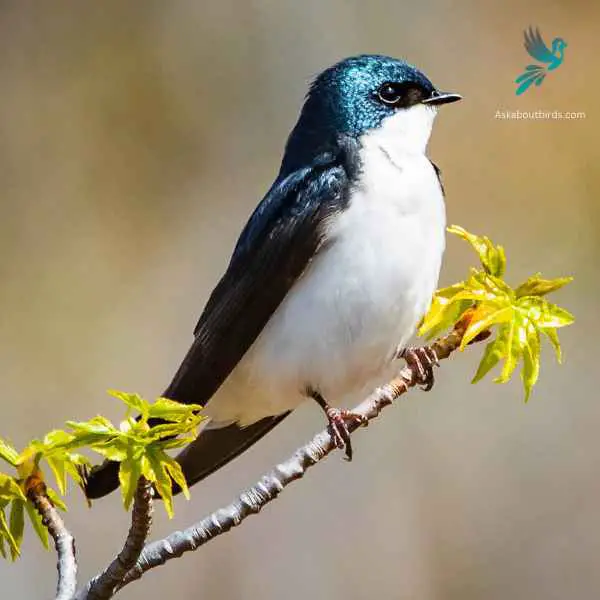
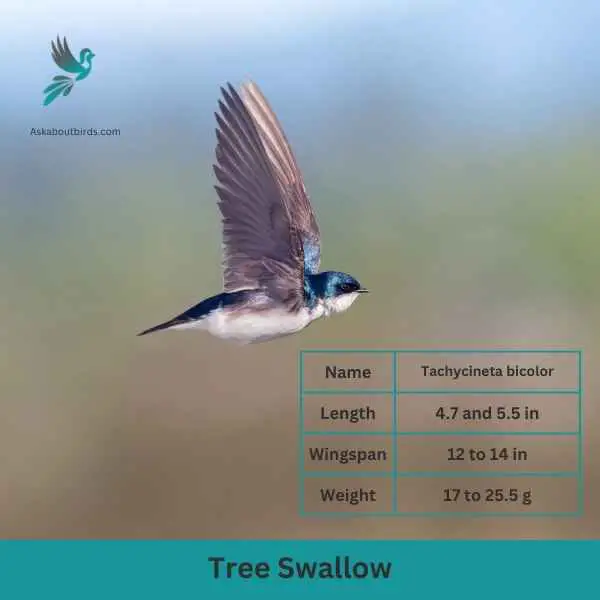
| Feature | Measurement |
|---|---|
| Scientific Name | Tachycineta bicolor |
| Length | 4.7 and 5.5 in |
| Wingspan | 12 to 14 in |
| Weight | 17 to 25.5 g |
The Tree Swallow is a graceful and agile bird, best recognized for its iridescent blue-green upperparts and sweeping flight patterns over open fields and water.
Appearance: The Tree Swallow is sleek with a streamlined body. The upperparts shine with a blue-green iridescence while the underparts are white. They possess long, pointed wings and a slightly forked tail, aiding in their agile flight.
Diet: Tree Swallows primarily feed on flying insects, skillfully catching them mid-air. During colder months when insects are scarce, they can switch to a diet of berries, particularly those of the bayberry, which other birds might find hard to digest.
Reproduction: Tree Swallows are cavity-nesters, typically choosing natural holes in trees or using bird boxes. They line their nests with feathers, creating a soft environment for the eggs. The female will lay a clutch of 4 to 7 white eggs.
Where to Spot Idaho’s Blue Birds
Idaho is a birdwatcher’s paradise, boasting a diverse range of habitats that attract a multitude of bird species, including several with striking blue plumage. Here are the top 3-5 locations in Idaho renowned for their avian diversity:
- Coeur d’Alene River Wildlife Management Area: This extensive wetland habitat is home to a variety of waterfowl and songbirds. During the spring and fall, it is an excellent location to spot migrating birds, including various species of ducks, geese, and shorebirds.
- Bear Lake National Wildlife Refuge: Located in southeastern Idaho, this refuge provides habitat for a variety of waterfowl, shorebirds, and raptors. It is a crucial stopover point for migrating birds and an excellent location to spot a wide variety of species throughout the year.
- Boise River Greenbelt: This urban oasis is a ribbon of natural habitat that stretches along the Boise River, providing an excellent opportunity to see a variety of bird species, including bluebirds, right in the heart of the city.
- Sun Valley: Located in central Idaho, Sun Valley and the surrounding areas offer a diverse range of habitats, from mountain forests to sagebrush steppe, attracting a wide variety of bird species, including Mountain Bluebirds and Steller’s Jays.
- Silver Creek Preserve: This high-desert spring creek ecosystem is one of the premier birdwatching locations in the state. It attracts a variety of waterfowl, shorebirds, and songbirds, making it an excellent location for spotting a diverse range of bird species.
| Neighboring State | Best Spots for Blue Birds |
|---|---|
| Montana’s Blue Birds | 1. Glacier National Park 2. Lee Metcalf National Wildlife Refuge 3. Ninepipe Wildlife Management Area |
| Nevada’s Blue Birds | 1. Red Rock Canyon National Conservation Area 2. Ash Meadows National Wildlife Refuge 3. Great Basin National Park |
| Oregon’s Blue Birds | 1. Malheur National Wildlife Refuge 2. Mount Hood National Forest 3. William L. Finley National Wildlife Refuge |
| Washington’s Blue Birds | 1. Ridgefield National Wildlife Refuge 2. Mount Rainier National Park 3. North Cascades National Park |
| Wyoming’s Blue Birds | 1. Grand Teton National Park |
FAQs on Blue Bird Species Found in Idaho
How do nest cavities influence the presence of bluebirds?
Nest cavities are crucial for the survival and breeding of bluebirds. Bluebird species, including the male mountain bluebird, prefer to nest in natural or artificial cavities like nest boxes. These cavities provide them with protection from predators, harsh weather, and also offer a safe place to lay their eggs and raise their young. However, bluebirds face competition for these cavities from house sparrows, European starlings, and house wrens, which are other bird species that also seek out similar nesting sites. Therefore, the availability of nest cavities greatly influences the presence and breeding success of bluebirds in an area.
How do barn swallows differ from other bluebirds?
Barn swallows and bluebirds, such as the male mountain bluebird, are different species with distinct characteristics and behaviors. Barn swallows have a light blue upper body, a red throat, and a forked tail, while male mountain bluebirds have a bright blue plumage and a gray belly. Barn swallows typically build their nests from mud and attach them to the eaves of buildings or cliffs, whereas bluebirds prefer nest cavities in dead trees or nest boxes. Also, barn swallows feed on flying insects caught in the air, while bluebirds forage for insects on the ground and also eat small fruits. These differences make barn swallows and bluebirds distinct from each other in terms of appearance, nesting habits, and diet.
